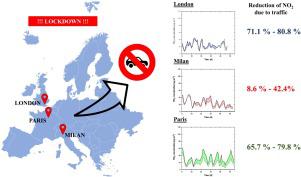当前位置:
X-MOL 学术
›
Process Saf. Environ. Prot.
›
论文详情
Our official English website, www.x-mol.net, welcomes your
feedback! (Note: you will need to create a separate account there.)
Analysis of lockdown for CoViD-19 impact on NO2 in London, Milan and Paris: What lesson can be learnt?
Process Safety and Environmental Protection ( IF 6.9 ) Pub Date : 2021-02-01 , DOI: 10.1016/j.psep.2020.12.029 Maria Cristina Collivignarelli , Claudio De Rose , Alessandro Abbà , Marco Baldi , Giorgio Bertanza , Roberta Pedrazzani , Sabrina Sorlini , Marco Carnevale Miino
Process Safety and Environmental Protection ( IF 6.9 ) Pub Date : 2021-02-01 , DOI: 10.1016/j.psep.2020.12.029 Maria Cristina Collivignarelli , Claudio De Rose , Alessandro Abbà , Marco Baldi , Giorgio Bertanza , Roberta Pedrazzani , Sabrina Sorlini , Marco Carnevale Miino

|
Nitrogen dioxide (NO2) can have harmful effects on human health and can act as a precursor for the formation of other air pollutants in urban environment such as secondary PM2.5 and ozone. The lockdown measures for CoViD-19 allowed to simulate on a large scale the massive and prolonged reduction of road traffic (the main source for NO2 in urban environment). This work aims to selectively assess the maximum impact that total traffic blocking measures can have on NO2. For this reason, three megacities (London, Milan and Paris) were chosen that had similar characteristics in terms of climatic conditions, population, policies of urban traffic management and lockdown measures. 52 air quality control units have been used to compare data measured in lockdown and in the same periods of previous years, highlighting a significant decrease in NO2 concentration due to traffic (London: 71.1 % - 80.8 %; Milan: 8.6 % - 42.4%; Paris: 65.7 % - 79.8 %). In 2020 the contribution of traffic in London, Milan and Paris was dropped to 3.3 ± 1.3 µg m-3, 6.1 ± 0.8 µg m-3, and 13.4 ± 1.5 µg m-3, respectively. Despite the significant reduction in the NO2 concentration, in UT stations average NO2 concentrations higher than 40 µg m-3 were registered for several days. In order to reduce the pollution, the limitation of road traffic could be not enough, but a vision also aimed at rethink the vehicles and their polluting effects should be developed.
中文翻译:

伦敦、米兰和巴黎封锁 CoViD-19 对 NO2 的影响分析:可以吸取什么教训?
二氧化氮 (NO2) 会对人体健康产生有害影响,并可作为形成城市环境中其他空气污染物(如二次 PM2.5 和臭氧)的前体。CoViD-19 的封锁措施允许大规模模拟道路交通(城市环境中二氧化氮的主要来源)的大规模和长期减少。这项工作旨在有选择地评估总体交通阻塞措施对二氧化氮的最大影响。出于这个原因,选择了三个在气候条件、人口、城市交通管理政策和封锁措施方面具有相似特征的特大城市(伦敦、米兰和巴黎)。已使用 52 个空气质量控制单位来比较锁定期间和前几年同期测量的数据,强调交通导致二氧化氮浓度显着下降(伦敦:71.1 % - 80.8 %;米兰:8.6 % - 42.4%;巴黎:65.7 % - 79.8 %)。2020 年,伦敦、米兰和巴黎的交通贡献分别降至 3.3 ± 1.3 µg m-3、6.1 ± 0.8 µg m-3 和 13.4 ± 1.5 µg m-3。尽管 NO2 浓度显着降低,但在 UT 站中,连续几天记录了高于 40 µg m-3 的平均 NO2 浓度。为了减少污染,限制道路交通是不够的,但还应该制定一个旨在重新思考车辆及其污染影响的愿景。分别为 5 µg m-3。尽管 NO2 浓度显着降低,但在 UT 站中,连续几天记录了高于 40 µg m-3 的平均 NO2 浓度。为了减少污染,限制道路交通是不够的,但还应该制定一个旨在重新思考车辆及其污染影响的愿景。分别为 5 µg m-3。尽管 NO2 浓度显着降低,但在 UT 站中,连续几天记录了高于 40 µg m-3 的平均 NO2 浓度。为了减少污染,限制道路交通是不够的,但还应该制定一个旨在重新思考车辆及其污染影响的愿景。
更新日期:2021-02-01
中文翻译:

伦敦、米兰和巴黎封锁 CoViD-19 对 NO2 的影响分析:可以吸取什么教训?
二氧化氮 (NO2) 会对人体健康产生有害影响,并可作为形成城市环境中其他空气污染物(如二次 PM2.5 和臭氧)的前体。CoViD-19 的封锁措施允许大规模模拟道路交通(城市环境中二氧化氮的主要来源)的大规模和长期减少。这项工作旨在有选择地评估总体交通阻塞措施对二氧化氮的最大影响。出于这个原因,选择了三个在气候条件、人口、城市交通管理政策和封锁措施方面具有相似特征的特大城市(伦敦、米兰和巴黎)。已使用 52 个空气质量控制单位来比较锁定期间和前几年同期测量的数据,强调交通导致二氧化氮浓度显着下降(伦敦:71.1 % - 80.8 %;米兰:8.6 % - 42.4%;巴黎:65.7 % - 79.8 %)。2020 年,伦敦、米兰和巴黎的交通贡献分别降至 3.3 ± 1.3 µg m-3、6.1 ± 0.8 µg m-3 和 13.4 ± 1.5 µg m-3。尽管 NO2 浓度显着降低,但在 UT 站中,连续几天记录了高于 40 µg m-3 的平均 NO2 浓度。为了减少污染,限制道路交通是不够的,但还应该制定一个旨在重新思考车辆及其污染影响的愿景。分别为 5 µg m-3。尽管 NO2 浓度显着降低,但在 UT 站中,连续几天记录了高于 40 µg m-3 的平均 NO2 浓度。为了减少污染,限制道路交通是不够的,但还应该制定一个旨在重新思考车辆及其污染影响的愿景。分别为 5 µg m-3。尽管 NO2 浓度显着降低,但在 UT 站中,连续几天记录了高于 40 µg m-3 的平均 NO2 浓度。为了减少污染,限制道路交通是不够的,但还应该制定一个旨在重新思考车辆及其污染影响的愿景。











































 京公网安备 11010802027423号
京公网安备 11010802027423号